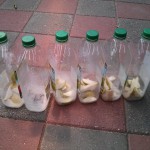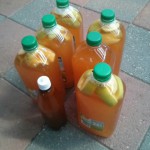It’s 1-all in the all grain BIAB competition, my first BIAB pale ale is awesome, my second not so much. I was keen to replicate the last brew with better quality grains, a bit more hops, and (hopefully) better mash temperature control. However my LHBS of choice seems to be pretty much out of every malt I can think of so I’ve had to come up with an alternate recipe. I know that’s not scientific but hey, it’s coming up to summer and beer is running short!
Pilsner Malt (3.7EBC) 2.6kg
Bairds Pale Crystal 0.15kg (what I’ve got left)
Munich II Malt (24EBC) 0.35kg
13g Magnum @ 60 minutes (12.7%AA)
18g Cascade @ 10 minutes (5.6%AA)
12g Cascade @ Flameout for 10 minutes (5.6%AA)
14g Cascade, dry hop after 7 days for a week
Danstar Nottingham Ale Yeast
Brew Type : 12.5L All Grain (BIAB)
OG: 1.054
FG: 1.014
ABV: 5.6%
IBU: 36.6
EBC: 15.9
The logic behind this recipe goes something like this:
- Pilsner should be nice and light and give a drinkable beer in hot weather.
- The Pale Crystal in the cupboard and I may as well use it.
- I like the malt hit the Munich gave me in my last brew so I’ll try it again.
- A few grams more Magnum up front for more bitterness and dry hopping (for the first time in a BIAB brew for me) to get some nice hop aroma.
- Nottingham Ale Yeast because it has a reputation of good attenuation and I’ll still like a dryer beer for the hotter weather.
Brew Day (31 October 2015)
The first thing I did a couple of days before the brew was to split the Nottingham Ale Yeast into equal parts and create two 500mL/100g DME starters in sterilised glass jars. Once those had done fermenting (24 hours) and allowed to settle I carefully drained off the expended wort leaving the creamy yeast at the bottom and topped them off with boiled water. Both were stored safely, one to be used with this brew, and the other for the next.
On brew day I followed my usual method as follows:
1. Bring 10L of water to strike temperature of 71C with grain bag lining pot. I used 10L of mash water gain to get more thermal mass to stop heat loss during the mash process.
2. Add grain bill, stir to ensure no dough balls.
3. Took temperature of mash (67.5C) replaced lid on pot, and wrapped pot in doona for 60 minutes to mash. I noted that the temperature was dropping rather quickly so after 10 minutes I put the pot back on the heat. I was standing on the doona and noted it was quite cold. Drawing the conclusion that one layer of doona under the mash pot was just not insulating it enough (heat escaping into my tiled/concrete floor) I doubled the bottom layer and put the pot back into it’s blankie.
4. Bring 7L of water to 75C in another pot.
5. At the end of 60 minutes unwrap pot, take temperature again (65.5C). I drained the bag on a wire rack suspended over the brew pot for several minutes.
6. Sparged the bag with the 75C water until there was a litre or two left and put the bag in the sparge pot to sit for a few minutes before squeezing the whole lot and trying to extract as much sweet wort as possible.
7. I’d managed to almost fill the whole 15L pot at this stage with 14L of wort. I took a gravity reading (1.037 @ 54.0C), added a few drops of FERMCAPs to stop boil-overs and brought it all to the boil.
8. Last brew I made little muslin hop bags but they didn’t seem to affect the clarity of the brew so I didn’t bother this time. Once boiling I made the hop additions at 60, 10, and 0 minutes. At the end of the boil I had 12L of wort left (2L loss).
9. It’s at this point that I’d usually be cooling the wort in an ice bath but I couldn’t be jacked. The whole pot was put in my fermentation fridge and chilled overnight to 18C ready for pitching in the morning. I suspect this will lead to less clarity in the beer but I am fairly certain I don’t mind drinking cloudy beer so I am happy with the lower amount of effort involved.
10. (Morning of 1 November 2015). The wort was at 18C so I drained it into my fermentation vessel through a strainer leaving me with 11L of wort which was then topped off with cooled boiled water. I took a gravity reading (1.053 @ 17.7C), aerated with my giant sterilised spoon and pitched the Nottingham Ale yeast starter that I’d prepared earlier. The FV then went into my fridge with a set temp of 18.5C where it’ll sit for 10 days before I dry hop.
Overall I’m happy with how the day went. I almost hit almost all my numbers just missing the OG by a little and maintaining a nice constant mash temperature. Not having to chill the wort was great and I’ll be interested to see what impact the over night chilling had. If the beer is of the quality of my first BIAB effort I’ll be more than happy!
Mash Efficiency
2.6KG of Pilsner malt has a potential of 1.038 points per gallon. I’ve got 5.72lb of grain in 3.7 (14L) gallons of water so the potential for the GP is 58.7 points.
0.35KG of Munich II malt has a potential of 1.037 points per gallon (0.35*2.2*37/3.7) and 0.15kg of Bairds Pale Crystal has a potential of 1.035 points per gallon (0.15*2.2*35/3.7). That’s 7.7 points for the Munich II and 3.1 points for the crystal.
Total potential is 69.5 points and with a measured pre-boil (and temperature corrected) gravity of 1.048 the mash efficiency was 69.0% (48/69.5) which is very similar to my last two all grain BIAB efforts.
Update 7/11/15
Took a gravity reading, 1.012. The sample was much darker than I expected and was extremely cloudy which is probably a result of the no chill approach I took to wort. Taste was perfectly good. Will make dry hop addition tomorrow (14g Cascade) and plan to cold crash on 12/11/15 in the AM before fining with gelatine on the evening of the same day. Allow 48 hours to clear and bottle next Saturday (14/11/15).



